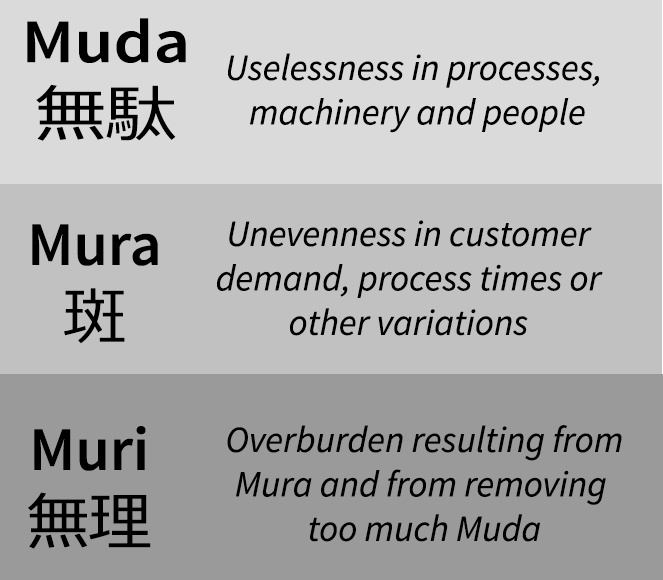Although the names may sound similar, Muda, Mura and Muri are three very different, but equally important factors in maintaining a safe and efficient manufacturing facility. When analyzed together, the 3M’s can be considered the three enemies of an efficient work place.
Muda
Muda can be simply defined as uselessness, or, more simply, waste. As if three M’s wasn’t enough, Muda can be broken down into eight different types.
- Defects – Time and effort spend inspecting for and fixing defects
- Overproduction – Producing more than what is in demand
- Waiting – Product or workers spending time waiting for next production step
- Non-used Talent – Underutilizing human potential
- Transport – Moving of products outside of what is required for processing
- Inventories – Having a backlog of product waiting for further processing or consumption
- Motion – The movement of workers or equipment to complete processing
- Excess Processing – nonvalue adding steps; more than what the customer is expecting
When looked at mnemonically, the components of Muda create the word DOWNTIME, which fitting in with the idea that Muda is defined as uselessness. Depending on resources, there are a few other mnemonics that can be used in this scenario such as TIMWOOD or WORMPIT, but they all have the same meaning behind them.
Having waste can lead to two undesirable monetary outcomes; inflated prices for consumers or lower profit margins for companies. Of course, neither one of these is desirable. As with everything in manufacturing, the elimination of Muda requires a balancing act of sorts, as not all waste can be eliminated in order to keep up with changing customer demands and potential supplier fluctuations.
Mura
Mura is variation or unevenness in production. A common example of how Mura works against efficiency can be based on customer demand. For instance, if customer demand rises towards the end of a quarter, followed by a month of slow sales, it would make sense to even out the workload over the quarter to avoid overworking employees, as well as unproductive downtime. Essentially, more Mura results in more Muda.
Muri
Have you ever installed a program on your computer that bogs everything down because there isn’t enough operating power? With the software running, it is almost impossible to complete any other task without having to wait. This is an example of Muri, or, overburden. When a machine or operator has to exhort more energy than designed to do through their natural limits, the time and quality of the product decreases while costs continue to increase. Muri can also lead to a variety of waste, or Muda throughout the production process.

With all three enemies, complete obliteration is often times not capable. However, analyzing Muda, Mura and Muri together can help manufacturing engineers identify and alter processes that are contributing to them.






